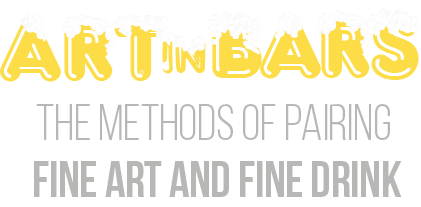Art in bars: The methods of pairing fine art and fine drink
October 5, 2017

People don’t often associate beer with art, but for the local and University communities, this pairing provides an appreciative and social outlet for fine art and fine beer. The Art in Bars series hosted by Samek Art Museum has held events in the past few years for individuals to sample beers and pair them with rarely-seen works of art from the Samek Art Gallery. On Oct. 3, the Samek held a new Art in Bars event at the Pine Barn Inn in Danville, Pa.
The inspiration
Richard Rinehart, director and chief curator of the Samek Art Museum, spearheaded the Art in Bars series to “burst the Bucknell bubble.” Rinehart shared that when he came to the University six years ago, he noticed a force that kept the University closed-off from its surrounding community, so he saw it as his mission to connect students and faculty with the outside public and share University resources with them. He believed that there was no better way to do this than by bringing University treasures to a common ground setting – a bar.
Public Programs and Outreach Manager Emily Izer said that the Art in Bars series also breaks down the elitism that can be associated with art. Many people don’t know how to interpret art and shy away from it, but placing art in a casual setting such as a bar makes it much more approachable. Izer explained that relating art to beer is an easy way for people to begin understanding and appreciating its meaning. Art in Bars has hosted events at the Rusty Rail Brewing Company and Civil War Cider in the past, and hopes to hold an event either on campus or close to campus next semester.
The event
This semester’s Art in Bars event was well-attended, with members of both the local and the University community. It began with an introduction from Rinehart explaining how the pairing worked. Attendees were asked to sample four types of beer, and vote on which of the four paintings they thought best paired with each beer. Rinehart suggested ways in which people could pair, but emphasized that there was no right answer and that it was based on personal associations. He encouraged people to discuss the ways in which they pair with fellow attendees and finished by contending, “This is basically just a drinking game with art.”
The event was achieved through a partnership between the Samek Art Museum, Pine Barn Inn, and Covered Bridge Brewhaus. The Samek provided the artwork, Pine Barn Inn offered the venue, and Covered Bridge Brewhaus brought the craft beers. Izer explained that Samek has over 6,000 pieces of artwork, but they were limited as to which ones they could bring. For that reason, they started by picking four viable pieces of art, and then went to Covered Bridge to sample the beers they thought matched best with the art. The beers chosen were brought by Covered Bridge’s brewer Eric Kuijpers, who started brewing 20 years ago. Covered Bridge started as a home brewery until going commercial three years ago. The Samek chose paintings from four different time periods, each with a unique style.
How to pair art with beer
The methods of pairing art and beer varied between each person at the event. In his introduction, Rinehart outlined five possible ways to match brews with paintings. One could look at what the artwork depicts (i.e. the scene, the smells, the sounds), what the artwork looks like (i.e. sharp, messy, clear), the time period the artwork is associated with, the title of the artwork, or how the artwork makes you feel. At the end of the event, after sharing the results of the voting, Rinehart began a discussion on how people paired the beer and art. Attendees had a range of different answers. Some people based their matches off color — the darker beers paired best with the darker paintings. Others paired using their visceral reactions to both the beers and the pieces of artwork. One woman said that certain pieces made her feel “warm” and “comfortable” like the beer she was drinking. While pairing beer with art is not a traditional ‘foodpairing’ example, it does allow members of the community to experience art in an accessible and communal fashion.





















